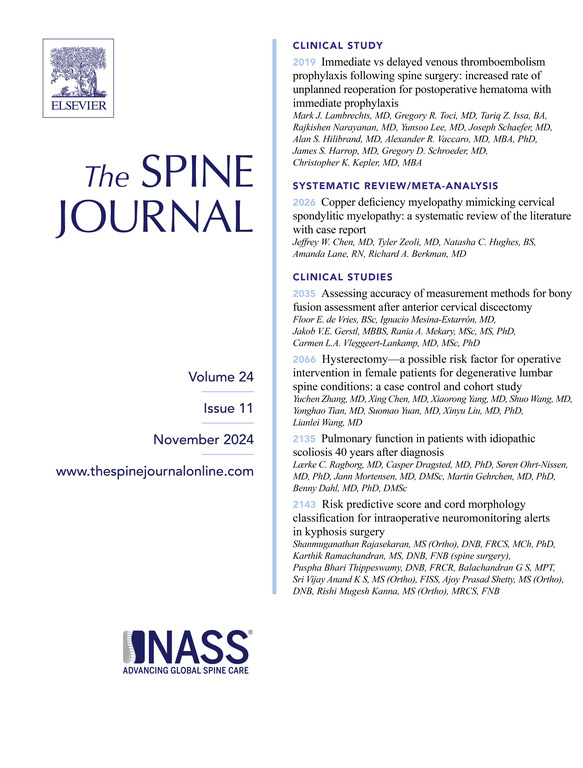使用安全机构大语言模型增强核磁共振脊柱成像申请表和自动协议。
IF 4.9
1区 医学
Q1 CLINICAL NEUROLOGY
引用次数: 0
摘要
背景环境:安全机构大语言模型(LLM)可减轻放射科医生的非解释性任务负担。目的:评估安全机构大语言模型在核磁共振脊柱成像申请表增强和自动协议方面的实用性:研究设计/设置:2023年12月至2024年2月期间进行的回顾性研究,包括可在电子病历(EMR)上查阅临床条目的患者:共分析了218名患者(平均年龄=55.9岁±18.9[SD];108名女性)的250份脊柱MRI申请表,涉及颈椎(n=56/250,22.4%)、胸椎(n=13/250,5.2%)、腰椎(n=166/250,66.4%)和全脊柱(n=15/250,6.0%)。其中,60/250(24.0%)需要造影剂,41/250(16.4%)之前接受过脊柱手术/器械检查:主要指标:临床医生和 LLM 增强申请表上临床信息的充分性采用四点量表评分。次要指标-与共识参考标准相比,LLM 和第一年获得委员会认证的放射科医生(Rad4 和 Rad5)提出的 MRI 方案建议的正确性:一名有保障的机构 LLM(Claude 2.0)使用多数决定提示(六次运行中)来增强临床医生使用 EMR 申请表上的临床信息,并建议适当的 MRI 方案。三位肌肉骨骼放射科医生(放射 1:10 年经验;放射 2:12 年经验;放射 3:10 年经验)对临床医生和 LLM 增强申请表上临床信息的充分性进行了独立评分。这些放射科医生为正确的方案提供了一致的参考标准,并将其与 LLM 和两名第一年获得委员会认证的放射科医生(Rad4 和 Rad5)建议的方案进行了比较。在适当的地方提供了总体一致性(评分者之间的弗莱斯卡帕或与参考标准的一致性百分比以及各自的 95%CIs ):结果:经 LLM 增强的表格在 93.6-96.0% 的病例中被放射医师评为具有足够的临床信息,而临床医师申请表的这一比例为 46.8-58.8%(p结论:增强脊柱 MRI 申请表的临床信息量在临床医师申请表中占比最高,为 93.6%-96.0%):使用安全的机构 LLM 增强脊柱 MRI 申请表提高了临床信息的充分性。LLM还能在78.4%的病例中准确建议正确的方案,从而优化核磁共振成像工作流程。本文章由计算机程序翻译,如有差异,请以英文原文为准。
MRI spine request form enhancement and auto protocoling using a secure institutional large language model
BACKGROUND CONTEXT
Secure institutional large language models (LLM) could reduce the burden of noninterpretative tasks for radiologists.
PURPOSE
Assess the utility of a secure institutional LLM for MRI spine request form enhancement and auto-protocoling.
STUDY DESIGN/SETTING
Retrospective study conducted from December 2023 to February 2024, including patients with clinical entries accessible on the electronic medical record (EMR).
PATIENT SAMPLE
Overall, 250 spine MRI request forms were analyzed from 218 patients (mean age = 55.9 years ± 18.9 [SD]; 108 women) across the cervical (n=56/250, 22.4%), thoracic (n=13/250, 5.2%), lumbar (n=166/250, 66.4%), and whole (n=15/250, 6.0%) spine. Of these, 60/250 (24.0%) required contrast and 41/250 (16.4%) had prior spine surgery/instrumentation.
OUTCOME MEASURES
Primary–Adequacy of clinical information on clinician and LLM-augmented request forms were rated using a four-point scale. Secondary–Correct MRI protocol suggestion by LLM and first-year board-certified radiologists (Rad4 and Rad5) compared to a consensus reference standard.
METHODS
A secured institutional LLM (Claude 2.0) used a majority decision prompt (out of six runs) to enhance clinical information on clinician request forms using the EMR, and suggest the appropriate MRI protocol. The adequacy of clinical information on the clinician and LLM-augmented request forms was rated by three musculoskeletal radiologists independently (Rad1:10-years-experience; Rad2:12-years-experience; Rad3:10-years-experience). The same radiologists provided a consensus reference standard for the correct protocol, which was compared to the protocol suggested by the LLM and two first-year board-certified radiologists (Rad4 and Rad5). Overall agreement (Fleiss kappas for inter-rater agreement or % agreement with the reference standard and respective 95%CIs) were provided where appropriate.
RESULTS
LLM-augmented forms were rated by Rads 1–3 as having adequate clinical information in 93.6-96.0% of cases compared to 46.8-58.8% of the clinician request forms (p<0.01). Substantial interobserver agreement was observed with kappas of 0.71 (95% CI: 0.67–0.76) for original forms and 0.66 (95% CI: 0.61–0.72) for LLM-enhanced requests. Rads 1–3 showed almost perfect agreement on protocol decisions, with kappas of 0.99 (95% CI: 0.94–1.0) for spine region selection, 0.93 (95% CI: 0.86–1.0) for contrast necessity, and 0.93 (95% CI: 0.86–0.99) for recognition of prior spine surgery. Compared to the consensus reference standard, the LLM suggested the correct protocol in 78.4% (196/250, p<0.01) of cases, albeit inferior to Rad4 (90.0%, p<0.01) and Rad5 (89.2%, p<0.01). The secure LLM did best in identifying spinal instrumentation in 39/41 (95.1%) cases, improved compared to Rad4 (61.0%) and Rad5 (41.5%) (both p<0.01). The secure LLM had high consistency with 227/250 cases (90.8%) having 100% (6/6 runs) agreement.
CONCLUSIONS
Enhancing spine MRI request forms with a secure institutional LLM improved the adequacy of clinical information. The LLM also accurately suggested the correct protocol in 78.4% of cases which could optimize the MRI workflow.
求助全文
通过发布文献求助,成功后即可免费获取论文全文。
去求助
来源期刊

Spine Journal
医学-临床神经学
CiteScore
8.20
自引率
6.70%
发文量
680
审稿时长
13.1 weeks
期刊介绍:
The Spine Journal, the official journal of the North American Spine Society, is an international and multidisciplinary journal that publishes original, peer-reviewed articles on research and treatment related to the spine and spine care, including basic science and clinical investigations. It is a condition of publication that manuscripts submitted to The Spine Journal have not been published, and will not be simultaneously submitted or published elsewhere. The Spine Journal also publishes major reviews of specific topics by acknowledged authorities, technical notes, teaching editorials, and other special features, Letters to the Editor-in-Chief are encouraged.
 求助内容:
求助内容: 应助结果提醒方式:
应助结果提醒方式:


